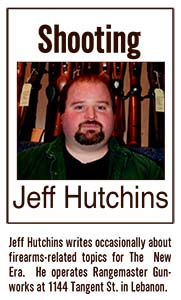In my last column, I noted that the bolt action rifle is king of the hill for a reason: About the only thing it sacrifices to the other repeaters is speed of follow-up shots. It’s more accurate than the lever, pump and single-shot, and it’s a strong rifle all the way around, especially on the price tag.
While the lever action has plusses and is also very popular, it has had its ups and downs, as I discussed.
This time around, we’ll look at some of the other action styles that have been popular in the past and are still in use today, starting with the semi-automatic.
Many attempts have been made to produce a semi-automatic sporting rifle; most are semi-successful.
The most common is the Remington 740/742/7400/FOUR/750 series.
I have written about them before, but to give an overview, they need to be cleaned and inspected by a gunsmith frequently, and shot a lot to verify the reliability with your chosen ammo. Don’t shoot heavily loaded factory ammo; they don’t like reloads. The newer the model, the better for reliability and inevitable parts replacement.
They do tend to be fairly accurate and the triggers are decent and can be improved.
These rifles were discontinued a few years ago and I doubt the new owners of Remington will bring them back.
Next will have to be the Browning BAR. Much like their BLR it is available in magnum calibers, the first sporting autoloader so offered.
The triggers on these rifles are usually acceptable and can be worked over to good effect. For some reason, their accuracy will sometimes just drop off for no apparent reason and it never comes back.
The two-piece stocks on these rifles, and all of the mechanisms hanging off of the barrels, makes them less consistently accurate than the bolt action.
Winchester made the Model 100 semi-auto, which is basically the Model 88, only with an autoloader instead of a lever action.
As an aside, thetr was a recall for the firing pin decades ago. The firing pin could break in half, lodge itself in the forward position and go uncontrollable full-auto.
The trigger is a little easier to work over than the Model 88 but still not fun.
Benelli makes a self-loading sporter as well. They are quite expensive and seem to be reliable so far. The downside is that I have only seen or heard reports of accuracy in the 2½- to 3-inch grouping at 100 yards.
All of these sporting semi-autos are poor second cousins to the military versions, always in reliability and usually in accuracy.
I would recommend choosing an AR-type rifle, FAL/L1A1, H&K 91/G3, M1 Garand or M-14/M1A instead. You are not stuck with .30 caliber either, especially in the AR -tyle rifles. These are known as Modern Sporting Rifles or MSRs.
I will personally not use traditional sporting semi-automatics for hunting. I guess it’s a by-product of having to fight with the bad ones, but I would take any of the military rifles mentioned above (and some others) out in the woods without hesitation, even after dangerous game.
One downside to all semi-autos is that in order to load them properly they have to be “slammed shut” while chambering a round, which disturbs the woods. It’s kind of like slamming your door right before starting a hunt.
I simply, currently, have no desire to take these rifles after deer, elk, antelope, etc. but definitely would use them for wild hogs or bear in certain circumstances.
You’ll notice the last two critters are the ones that fight back, that should say something for my faith in modern sporting rifles!
The pump action field is really limited to the Remington Models 760/7600/SIX family.
Yes, there were others like the Savage 170 and Timberwolf, but they are not common. The 76 series has an advantage in that the barrel is mostly, sometimes completely, free-floated and is much more reliable than the maker’s semi-autos. Just like the autos the trigger can be worked over to a most useable pull weight and feel.
The Remington pump shooter who can control the urge to “spray and pray” is well-armed. The rifles are sometimes a little “rattlly” while being carried in the woods, but most of the auto’s failings are not present in the pump action.
Let’s not forget the lowly single shot. This is most definitely an expert’s rifle, as the second shot is a long time coming. I know Quigley could do it, but this ain’t Hollywood and you ain’t Tom Selleck.
Most likely, this style of rifle has killed more game and humans than all other arms combined, since it was in service for hundreds of years before any of the others made an appearance, 150 years ago or less, in most cases.
Most single shots are of the two-piece stock design but have nice barrels and triggers. Not quite as accurate as a whole as the bolt rifle, they add another level of fair chase to hunting and are cool to boot.
The strength of some actions (like the Ruger #1 and #3) is legendary, but keep in mind that not all singles are that strong; some are quite weak.
One of my favorite lines however was written by Jack O’Conner, of single shots: “Most riflemen will have a fling with the single shot at some point, then they will grow up.”
Sorry Mr. O’Conner but some of us don’t ever plan to grow up.
I hunt with all of these rifles, occasionally – mostly with bolt actions, frequently with the lever action and rarely with a single or pump action rifle.
I do have a double rifle I plan to use on my next elk hunt, however, but that’s a story for another time.
– Jeff Hutchins is a regular contributor to Lebanon Local. He owns and operates Rangemaster Gunworks in Lebanon.





